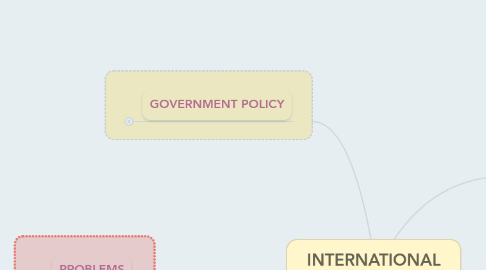
1. BENEFITS
1.1. Current account surplus
1.1.1. Likely to run current account surpluses on the BofP.
1.1.1.1. As exports are GREATER than imports
1.2. International Investment
1.2.1. Current account surplus allow country to invest overseas. Earning interest, profit, and dividend.
1.2.2. Competitive economy attracts FDI
1.2.2.1. Foreign firms may set up factories in UK to sell in domestic market or use as export base.
1.2.2.2. Foreign firms might want to buy domestic firms to exploit competitiveness.
1.3. Employment
1.3.1. Exports are higher than imports , creating jobs in domestic economy. Reducing unemployment.
1.4. Economic Growth
1.4.1. In developing countries competitiveness from low wages.
1.5. Wage growth
1.5.1. Increase in imports and greater demand for for workers
1.5.1.1. Wages likely to rise, benefiting workers
1.6. Higher domestic Purchasing~Power
1.6.1. Consumers benefit from higher incomes and growth
1.6.2. Consumers can purchase more goods + services at a lower price, therefore, more attractive.
2. PROBLEMS
2.1. Wages
2.1.1. For low and middle income countries
2.1.1.1. Benefit of low wage is not likely to last as country becomes more developed, wages will rise at a relatively high rate.
2.2. Other costs
2.2.1. Likely to rise as countries become more developed. i.e. price of land and materials.
2.3. Current account surplus
2.3.1. Lead to rise in exchange rates
2.3.1.1. Exports more expensive and imports cheaper for domestic buyers.
2.4. Trade barriers
2.4.1. Less competitive countries likely to impose trade barriers to protect their industries.
3. GOVERNMENT POLICY
3.1. Supply Side Policies
3.1.1. Training + Education will increase LR labour productivity
3.1.1.1. Increase competitiveness
3.1.2. Tax incentives on investment, will increase investment on capital, reducing costs
3.1.2.1. Increase competitiveness
3.2. Exchange rates policies
3.2.1. Other countries intervene in foreign currency markets to aid exporters.
3.3. Control of inflation and macroeconomic stability
3.3.1. High inflation leads to higher export prices
3.3.1.1. Leading to further inflation as workers demand higher wages to compensate for loss of earning power.
3.3.2. Stable macroeconomics enviroment encourages firms to invest and innovate.
3.3.2.1. Aiding export performance
4. MEASURING
4.1. Relative unit labour costs
4.1.1. Total Wages/Real Output
4.1.1.1. A rise, shows that labour costs per unit output rising faster in the UK than in other countries.
4.1.1.1.1. LESS COMPETITIVE
4.1.1.2. A fall, shows that labour costs per unit output falling less fast than other countries
4.1.1.2.1. MORE COMPETITIVE
4.2. Relative export prices
4.2.1. UK export prices compared to UK's main trading partners
4.2.1.1. A rise, means UK export prices have risen faster or fallen less than those of the UK's main trading partners.
4.2.1.1.1. LESS COMPETITIVE
4.2.1.2. A fall, means UK export prices have fallen faster to risen less than those of the UK's main trading partners
4.2.1.2.1. MORE COMPETITIVE
4.3. Export prices compared to import prices
4.3.1. If UK export prices rise faster than UK import prices
4.3.1.1. LESS COMPETITIVE
4.3.2. If UK import prices rise faster than UK export prices
4.3.2.1. MORE COMPETITIVE
4.3.3. Can be affected by commodity prices and exchange rates.
5. FACTORS
5.1. Exchange Rates
5.1.1. Rise in UK exchange rate likely to make UK goods less competitive and imports more competitive.
5.1.2. Fall in UK exchange rate likely to make UK goods more competitive and imports less competitive.
5.1.3. Evaluation:
5.1.3.1. Extent to which competitiveness is effects depends on price elasticity of demand.
5.1.3.1.1. Inelastic - no change in competitiveness
5.1.3.1.2. Elastic - large change in competitiveness
5.1.3.2. How firms respond will also affect competitiveness
5.1.3.2.1. If export firms keep foreign currency prices the same - no change in competitiveness: LR effects on profit and investment
5.2. Productivity
5.2.1. Rise in UK productivity compared to main trading partners increase UK's competitiveness
5.2.1.1. Cut in prices
5.2.2. Fall in UK productivity compared to mean trading partners reduce UK's competitiveness.
5.3. Wage and non-wage costs
5.3.1. Rise relative to main trading partners, UK will become less internationally competitive
5.3.1.1. Increase in prices
5.3.2. Evaluation
5.3.2.1. Depends on rise depends on factors such as increases in labour productivity.
5.3.2.2. Depends on whether firms are prepared to change profit margins.
5.4. Regulation
5.4.1. Increase, leads to increase in cost of productions.Increassing prices
5.4.1.1. LESS COMPETITIVE
5.4.2. Decrease, leads to decrease in cost of production. Decreasing prices
5.4.2.1. MORE COMPETITIVE
5.4.3. Evaluation
5.4.3.1. Impact on workers in terms of safety
5.4.3.2. Could impact inequality
5.5. Quality
5.5.1. Firms that produce better quality products than international rivals will have competitive advantage.
5.5.1.1. UK have avoided price competition with cheap labour countries. Producing unique better quality products.
5.6. Research & Development
5.6.1. Large R&D, increase LR international competitiveness
5.7. Taxation
5.7.1. Low taxes on profits encourage investment and innovation.
5.7.1.1. MORE COMPETITIVE
5.7.2. High taxes on profit
5.7.2.1. LESS COMPETITIVE
